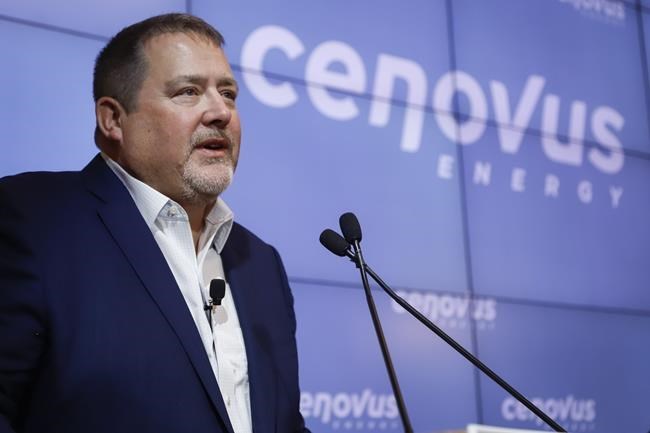CALGARY — The chief executive of Cenovus Energy Inc. sent a blunt message to governments Wednesday when he told analysts on a conference call that a recently unveiled federal tax credit won't be enough to convince Canada's major oilsands producers to begin construction on a proposed massive carbon capture and storage transportation line.
Industry will need "more help" than just a tax credit if it's going to go ahead with large-scale carbon capture and storage and other emissions reduction initiatives like those proposed by the Oil Sands Pathways to Net Zero consortium, said Alex Pourbaix, whose company is part of that alliance of oilsands firms along with Canadian Natural Resources Ltd., ConocoPhillips, Imperial Oil Ltd., MEG Energy Corp., and Suncor Energy Inc.
"These are multibillion-dollar projects. And we have to have certainty that they are investable, and that we can manage those investments over the entire commodity price cycle," Pourbaix said.
"I suspect, over the long term, much as we've seen in other jurisdictions, we're going to require a real collaboration."
Carbon capture and storage is a technology that captures greenhouse gas emissions from industrial sources and stores them deep in the ground to prevent them from being released into the atmosphere.
Proponents say a large-scale rollout of carbon capture and storage technology will be necessary if Canada is to meet its climate goals. According to environmental think tank The Pembina Institute, capturing and storing CO2 from oilsands facilities, refineries and gas plants could reduce Canada's emissions by 15 million tonnes by 2030 — the equivalent to taking 4.6 million passenger vehicles off the road.
But carbon capture technology is expensive and so far, has proved difficult to scale. There are only a handful of carbon capture projects up and running in Canada right now, though many more have been proposed. The Oil Sands Pathways group, for example, has proposed to work together on a project that would capture CO2 from oilsands facilities and transport it to a storage facility near Cold Lake, Alta, delivering about 10 million tonnes of emissions reductions per year from oilsands production.
Oilsands companies have long advocated for some form of tax credit incentive to help industry invest in the technology, saying such an incentive would be critical to getting large-scale projects off the ground.
In last month's federal budget, the Liberal government announced such an incentive, in spite of opposition from some environmentalists who viewed the move as nothing more than a subsidy for fossil fuel production. Starting this year, companies will be able to claim a tax credit of up to 60 per cent for direct air capture projects and 50 per cent for all other eligible carbon capture projects. A 37.5 per cent tax credit is available for investment in equipment for carbon transportation, storage and use.
While the federal tax credit is a "good start," Pourbaix said, in some parts of the world, governments have provided up to 60 or 70 per cent of the capital costs of new carbon capture projects, in addition to providing operating support. He said the Pathways alliance will need more detail about what kind of additional support to expect before it can make a final investment decision.
But Warren Mabee — director of the Institute for Energy and Environmental Policy at Queen's University in Kingston, Ont. — said Pourbaix's comments make for poor optics, given that they came the same day Cenovus announced a first-quarter profit of $1.6 billion, or 81 cent per share, compared with a profit of $220 million or 10 cents per share in the first quarter of 2021. Revenue totalled $16.2 billion, up from $9.3 billion in the same quarter last year.
Canadian oilsands producers have been posting huge profits and record cash flows against the backdrop of the war in Ukraine, post-pandemic economic recovery, and soaring global energy demand. Cenovus also announced Wednesday the tripling of its quarterly dividend, to 42 cents per share a year, up from 14 cents per share a year.
"Basically the message is, we'll profiteer today but we aren't willing to sink our profits into creating a cleaner and greener industry," Mabee said. "Cenovus would do well to highlight what investments they have made, and how they are reinvesting windfall profits in creating a more sustainable future for their shareholders and their sector."
During the call, Pourbaix said Cenovus and the rest of the Pathways group — which have jointly set the goal of reducing emissions from oilsands production by 35 per cent by 2035 and to reach net-zero emissions by 2050 — continue to have discussions with both the federal government and the Alberta provincial government. In the meantime, he said preliminary engineering and permit applications for the carbon capture project have already begun.
He also pointed out that oil prices are cyclical, and the industry has only very recently emerged from years of depressed prices. He said when it comes to the construction of the proposed carbon capture and storage transportation line, current oil prices shouldn't be banked on.
"Oil prices right now are obviously very attractive, but we know probably before that project is ever in service, we'll probably test the bottom end of those prices again," he said.
This report by The Canadian Press was first published April 27, 2022.
Companies in this story: (TSX:CVE)
Amanda Stephenson, The Canadian Press



